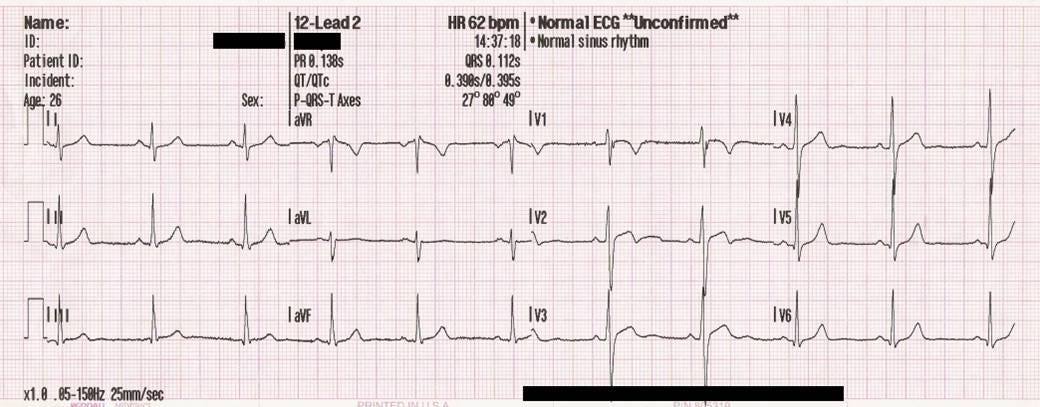Downloads: 1
Diff of
/README.md
[000000]
..
[c5b8c2]
Switch to side-by-side view
--- a +++ b/README.md @@ -0,0 +1,108 @@ +# ECG_Heartbeat_Classification + +Description of the approach : https://blog.goodaudience.com/heartbeat-classification-detecting-abnormal-heartbeats-and-heart-diseases-from-ecgs-913449c2665 + +Requirement : Keras, tensorflow, numpy + +# Heartbeat Classification : Detecting abnormal heartbeats and heart diseases from +ECGs + + +<span class="figcaption_hack">Figure 1 : +[https://en.wikipedia.org/wiki/Electrocardiography](https://en.wikipedia.org/wiki/Electrocardiography)</span> + +An ECG is a 1D signal that is the result of recording the electrical activity of +the heart using an electrode. It is one of the tool that cardiologists use to +diagnose heart anomalies and diseases. + +In this blog post we are going to use an [annotated +dataset](https://www.kaggle.com/shayanfazeli/heartbeat) of heartbeats already +preprocessed by the authors of [this paper](https://arxiv.org/abs/1805.00794) to +see if we can train a model to detect abnormal heartbeats. + +### Dataset + +The original datasets used are [the MIT-BIH Arrhythmia +Dataset](https://www.physionet.org/physiobank/database/mitdb/) and [The PTB +Diagnostic ECG Database](https://www.physionet.org/physiobank/database/ptbdb/) +that were preprocessed by [1] based on the methodology described in III.A of the +paper in order to end up with samples of a single heartbeat each and normalized +amplitudes as : + + +<span class="figcaption_hack">Figure 2 : Example of preprocessed sample from the MIT-BIH dataset</span> + +MIT-BIH Arrhythmia dataset : + +* Number of Categories: 5 +* Number of Samples: 109446 +* Sampling Frequency: 125Hz +* Data Source: Physionet’s MIT-BIH Arrhythmia Dataset +* Classes: [’N’: 0, ‘S’: 1, ‘V’: 2, ‘F’: 3, ‘Q’: 4] + +The PTB Diagnostic ECG Database + +* Number of Samples: 14552 +* Number of Categories: 2 ( Normal vs Abnomal) +* Sampling Frequency: 125Hz +* Data Source: Physionet’s PTB Diagnostic Database + +The published preprocessed version of the MIT-BIH dataset does not fit the +description that authors provided of it in their paper as the former is heavily +unbalanced while the latter is not. This made it so my results are not directly +comparable to theirs. I sent the authors an email to have the same split as them +and I’ll update my results if I get a reply. A similar issue exists for the PTB +dataset. + +### Model + +Similar to [1] I use a neural network based on 1D convolutions but without the +residual blocks : + +<span class="figcaption_hack">Figure 3 : Keras model</span> + +Code : + +### Results + +MIT-BIH Arrhythmia dataset : + +* Accuracy : **98.5** +* F1 score : **91.5** + +The PTB Diagnostic ECG Database + +* Accuracy : **98.3** +* F1 score : **98.8** + +### Transferring representations + +Since the PTB dataset is much smaller than the MIT-BIH dataset we can try and +see if the representations learned from MIT-BIH dataset can generalize and be +useful to the PTB dataset and improve the performance. + +This can be done by loading the weights learned in MIT-BIH as initial point of +training the PTB model. + +From Scratch : + +* Accuracy : **98.3** +* F1 score :** 98.8** + +Freezing the Convolution Layer and Training the Fully connected ones : + +* Accuracy : **95.6** +* F1 score : **96.9** + +Training all layers : + +* Accuracy : **99.2** +* F1 score : **99.4** + +We can see the freezing the first layers does not work very well. But if we +initialize the weights with those learned on MIT-BIH and train all layers we are +able to improve the performance compared to training from scratch. + +Code to reproduce the results is available at : +[https://github.com/CVxTz/ECG_Heartbeat_Classification](https://github.com/CVxTz/ECG_Heartbeat_Classification) +

 Datasets
Datasets
 Models
Models